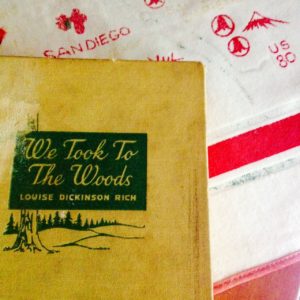Just in time for the weekend, here’s a little list of some of the things I’ve been listening to and reading this week, some of it online — Storyboard included, natch — and some of it on vinyl or actual ink and paper.
Two of my biggest loves are narrative journalism and music, and I’m lucky that my days are filled with both. When reading stories, I get inspired by songs I think fit the article’s theme — a soundtrack. Here are a couple of this week’s Storyboard articles, and their soundtracks:
Kate Christensen. “It is crucial to avoid grinding axes, settling scores and pointing fingers in your memoir. Kate Christensen has won the prestigious PEN/Faulkner Award for one of her novels, and just won the Maine Literary Award for memoir, so she knows something about creating characters who are imagined and real. She has this to say about the difference between the two endeavours:
Superficially, it’s the difference between remembering and imagining. In my memoir, I had to take a real, living, complex person—my mother, my sister, an old friend—and reduce her to a number of lines, words on the page, carefully chosen but always vastly incomplete, since any character in a memoir is part of your own story, not the protagonist in her own right. It felt like artful, difficult compression, the kind of compression that happens in poetry. In fiction, I create a character out of my own observations and interior apprehension of what it is to be human. At the beginning, I glimpse a gesture, an attitude, and from it I create an entire (I hope) complex, real-seeming person out of nothing but words. This feels like expansion. So fictional and nonfictional characters are created through essentially opposite endeavors.
But perhaps my favorite part of the discussion with her was her description of her new life in Maine, and what it taught her:
The air, the landscape, the weather, the people, the food, the ocean, the trees.… I don’t know, it’s mysterious, it just feels like Home to me. Who I am resonates with this place, my deepest self, the things I most love and want and need and value, I find here in such abundance, but I couldn’t have named them before I came. The longer I live here, the more I understand how essential this feeling is for sanity and well-being. Corny as it sounds, living here makes me feel like a better person.
Soundtrack: “I Feel Like Going Home,” by Yo La Tengo. I feel such love for Yo La Tengo, the most “real,” most adult band I know. They sing about relationships, their troubles and their joys, like few others. (But they’re loose enough to name the album this song is on “I Am Not Afraid of You and I Will Beat Your Ass.”)

Notable Narrative: Shane Bauer and “My Four Months as a Private Prison Guard.” Bauer’s story takes a serious time commitment; I can’t even imagine the minutes that one of those longform site “clocks” would say it takes to read. But it’s worth it, because it’s so rare to get a look at what it’s like behind prison walls. As you might guess, it’s not pretty. Davis Harper asks Bauer: When did you know that you had a really amazing story on your hands? And Bauer replied: I think right when I started. Once I was inside. I didn’t know how long it was going to last, and I still thought it could end at any moment. Even after two days of training, I thought I had a magazine story. I had enough for a magazine story after two days. Once I had been there for a while, it was clear it had to be a huge story. There was just so much that was happening that I saw, that the story couldn’t be without. I think my editors realized that right away as well. There was never even a stated time limit, because they understood this was going to be a huge story. They knew this was a once-in-a-lifetime opportunity.
Soundtrack: “Folsom Prison Blues,” by Johnny Cash. OK, it’s obvious. But Cash is so empathetic here. And you must listen to the version where he plays it live in the prison. The cheers! I recommend the whole album.
What I’m reading online: With Donald Trump now officially the Republican presidential nominee, I decided to read the buzzed-about Buzzfeed profile by McKay Coppins this week. It’s a psychological study, really, that goes to the heart of what seems to motivate Trump: He’s like an insecure kid saying “I’ll show you” to those who’ve looked down on him. (Oh, I’m proud to say that I remember when “short-fingered vulgarian” was used for the first time. Spy magazine was so good.) The other day, one of my co-workers suggested that we start a series on Storyboard called “One Great Line.” I think it’s a wonderful idea. Here’s one for the list: “Instead, Trump just sat there, stone-faced, stunned, simmering — Carrie at the prom covered in pig’s blood.”

What’s on my bedside table: After talking with Kate Christensen, I had to pick up “We Took to the Woods,” a memoir about life in the Maine woods by Louise Dickinson Rich, for about the hundredth time. I have several copies of the book, one of them a first edition that’s a little worse for wear; the beautiful illustrated jacket a distant memory. I love Christensen’s description of the book: “In her voice, those long Maine winters up in the wilderness are as glamorously fun as Manhattan penthouse cocktail parties, and through her eyes, backwoods Mainers, loggers and hunting guides and wardens and out-of-staters alike, are as funny and fascinating as Wodehouse characters, and her life with her husband is like ‘The Thin Man’ transported to the northern backcountry. She’s like the Nora Charles of the Allagash.” And I can relate to this line in the book itself: “It’s a very queer feeling to wake up and find that the dream has sneaked up on you and become a reality.”
What’s on my turntable: Although I spend most of my time listening to music on Spotify, sometimes I want to hear the needle touching down on vinyl. This week’s vinyl: “Bill Evans, From Left to Right.” He’s my favorite pianist, jazz or otherwise. To hear those opening notes of “My Foolish Heart” on the album “At the Village Vanguard,” all hushed ivories and cymbals, takes me back to a specific, very happy moment in my life. Isn’t it lovely how music can do that? It’s almost as strong a memory connector as the sense of smell. This album is slightly gimmicky: He plays both a Fender-Rhodes electric piano and a Steinway, but it’s still good. Gotta love the cover of him playing both pianos at once, a cigarette dangling from his lips.
If you want to suggest story soundtracks of your own, or just want to chat about storytelling or music, you can reach me at editor@niemanstoryboard.org. Or you can find me at @karihow on Twitter.


